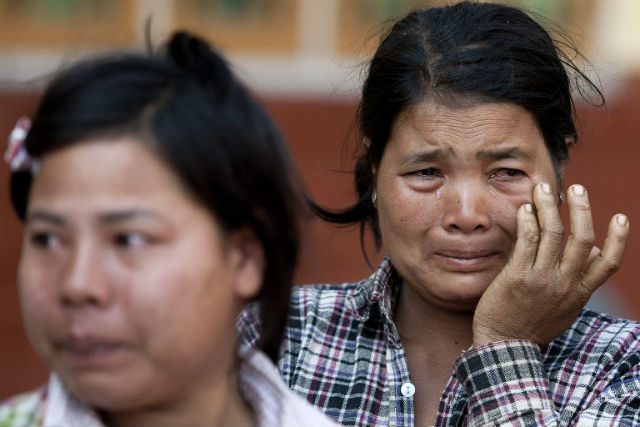SUMMARY
This is AI generated summarization, which may have errors. For context, always refer to the full article.

LASHIO, Myanmar – Nearly 90,000 civilians in northeastern Myanmar are believed to have fled clashes between troops and ethnic rebels, an official said Wednesday, as sporadic violence hampered efforts to evacuate those still trapped.
Rebels fear the national army is planning a major assault following the imposition of a state of emergency in the Kokang region of Shan state on February 17.
Whole towns and villages lie empty in the rugged, remote area as tens of thousands of residents have fled their homes – some on foot.
At least 30,000 people, mainly the ethnic Chinese Kokang, have crossed the border into China’s Yunnan province, alarming Beijing.
Clashes continued February 18 as more civilians arrived in the Shan town of Lashio, fearing they could be caught up in the sudden upsurge of violence.
In one of at least two separate attacks on civilians Tuesday, around 100 people came under fire as they travelled in Myanmar Red Cross trucks in a desperate dash from their homes.
“It was a miracle we weren’t hit,” Maung Ying told Agence France-Presse in Lashio after the attack on aid vehicles, which were marked with Red Cross flags but had no military protection.
“They were shooting from the mountains on both sides of the road. I thought I was going to die, bullets were passing just over our heads,” he said, adding the ordeal lasted for an hour.
The convoy had passed through Laukkai, the epicentre of fierce fighting since rebels launched attacks last week.
Tun Tun Oo, head of the Lashio Red Cross, which is separate from the better known International Committee of the Red Cross, said it was now too dangerous to go into Laukkai.
“We just have to wait for people to come to us. If the army could give us protection under military rule, then we would go back,” he said.
Both the army and rebels have blamed each other for the attack.
The United Nations Resident and Humanitarian Coordinator in Myanmar, Renata Dessallien, said she was “saddened” by the aid convoy attack, adding that it was in breach of humanitarian law.
“I appeal to all parties to the conflict to ensure that civilians are protected, and to allow civilians who remain in the conflict zone safe passage out of the Kokang area,” she said in a statement.
Civilian exodus
The violence, which flared on February 9, has killed dozens of soldiers and rebels. There is no official civilian death toll.
Laukkai’s ethnic Kokang MP Kyaw Ni Naing said he believed more than half of the region’s 140,000 people were on the move.
“There are many refugees fleeing from Laukkai town and nearby regions,” he told Agence France-Presse by telephone from the national capital Naypyidaw, adding that sporadic fighting had continued on Wednesday although the town itself was quiet.
He said around 8,000 people from central Myanmar had fled through Lashio, while some 40,000 Kokang had crossed into China. Another 40,000 people from Kokang and other ethnic minorities were thought to be scrambling for safety along the frontier.
China says it has stepped up border controls and called on all parties to prevent a further escalation of fighting.
Military activity in Lashio appeared to be increasing on Wednesday, despite an apparent lull in heavy fighting, with two helicopters and six trucks seemingly on standby at an army airstrip on the outskirts of town.
“The military is increasing its forces with tanks and heavy weapons in the region. We believe there will be more fighting,” said Captain Tar Parn Hla, spokesman for the Ta’ang National Liberation Army, which is fighting alongside the Kokang rebels.
He denied rebel involvement in the attack on the aid convoy, and accused the army of “intentionally” targeting civilians.
No one from the Myanmar government was available to comment.
It is the first major unrest in the region since 2009, when a huge assault by the army drove out rebel fighters, sending tens of thousands into China.
Myanmar’s quasi-civilian government has made signing a ceasefire with various ethnic rebel groups a key pillar of its reforms as the country heads towards a general election later this year.
But the fighting has raised fears those efforts are unravelling. – Rappler.com
Add a comment
How does this make you feel?
There are no comments yet. Add your comment to start the conversation.